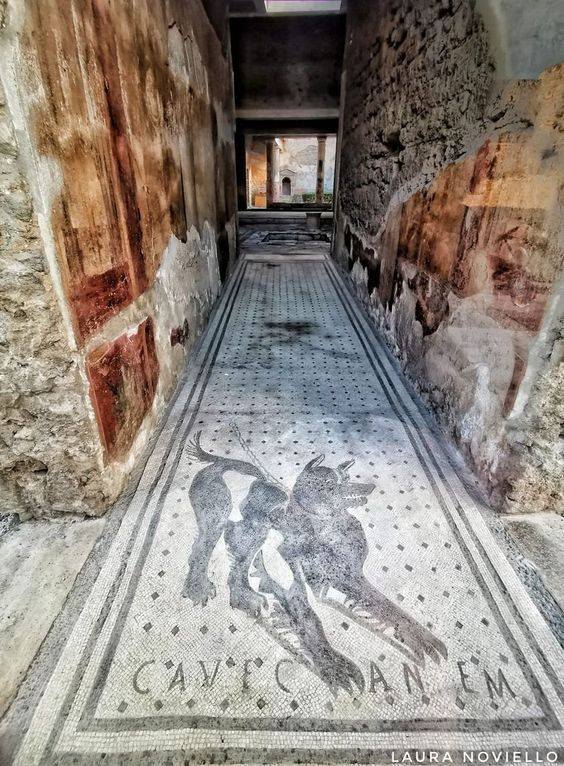In the ancient ruins of Pompeii, nestled along the timeworn streets once bustling with Roman life, stands one of the most captivating and well-preserved homes from antiquity—the House of the Tragic Poet. This exquisite residence, frozen in a moment by the catastrophic eruption of Mount Vesuvius in 79 AD, offers modern visitors a profound glimpse into the refined lifestyle of Pompeii’s elite during the 1st century AD. From the intricate mosaics to the grand architecture, this home speaks volumes about the cultural and artistic sophistication of the Roman world.

As visitors step through the threshold of this historic abode, they are immediately greeted by one of its most iconic features—a striking floor mosaic emblazoned with the Latin phrase “Cave Canem,” meaning “Beware of the Dog.” Depicting a snarling canine in vivid detail, this mosaic served both a practical and aesthetic purpose. For wealthy Romans, guard dogs were a common security measure, protecting their property and household. Yet, this warning was not simply utilitarian; it was also a display of artistry and status, reflecting the owner’s wealth and appreciation for craftsmanship. The “Cave Canem” mosaic embodies the Roman blend of functionality and artistic expression, and it remains one of the most famous visual symbols from Pompeii.
The House of the Tragic Poet derives its name from the elaborate frescoes that adorn its interior walls, particularly those that depict scenes inspired by Greek tragedy. These dramatic images, painted with remarkable skill, suggest that the homeowner possessed not only wealth but also a deep admiration for the theatrical arts and classical literature. The presence of such themes in the home’s artwork indicates a cultivated mind, familiar with the narratives of ancient drama and eager to express cultural sophistication through visual storytelling. By aligning their home with these themes, the owner projected an image of erudition and elite social standing.
Throughout the residence, vibrant frescoes bring to life a variety of mythological stories and legendary figures, drawn from both Greek and Roman traditions. These paintings are not merely decorative; they serve as windows into the beliefs, values, and interests of the Roman upper class. Rich in color and detail, the frescoes illustrate scenes of heroism, love, and divine intervention, revealing the artistic excellence and technical prowess of ancient Roman painters. Their enduring vibrancy and clarity after nearly two millennia testify to the high standards of Roman interior decoration and the care taken in their preservation.
Architecturally, the House of the Tragic Poet is a testament to the ingenuity and elegance of Roman residential design. At its core is an open-air atrium, a central courtyard that allowed sunlight to pour into the surrounding rooms. This feature was typical of Roman homes, fostering a sense of openness while serving as a hub for family life and social interaction. The layout of the house was meticulously planned to promote both function and aesthetic pleasure, with rooms arranged to maximize light, air, and flow.
Among the home’s many stunning features, the peristyle garden stands out as particularly enchanting. This lush, tranquil space was carefully cultivated with fragrant plants, artistic sculptures, and intricate mosaic flooring. Surrounded by a colonnade, the garden exemplifies the Roman love for harmonizing natural beauty with architectural refinement. It served not only as a place of relaxation but also as a display of wealth and taste. Guests would have been welcomed into this serene sanctuary, experiencing firsthand the homeowner’s appreciation for elegance and nature’s grace.
Archaeological discoveries made within the House of the Tragic Poet further illuminate the daily lives of its ancient inhabitants. Items such as furniture, pottery, and personal belongings have been unearthed, revealing the rhythms and routines of Roman domestic life. Even food remnants, including grains and dried fruits, have been preserved, offering insight into the dietary habits and culinary practices of Pompeii’s upper class. These artifacts paint a vivid picture of a home that was more than a mere dwelling—it was a center for intellectual conversation, artistic appreciation, and social exchange.
The tragic eruption of Mount Vesuvius, while devastating for the people of Pompeii, created an extraordinary preservation paradox. The thick layers of ash and pumice that buried the city also shielded its buildings and contents from the ravages of time. As a result, the House of the Tragic Poet was locked in a state of suspended animation, allowing future generations to witness the splendor of Roman domestic life with unparalleled clarity. Today, visitors walk through these ancient rooms and corridors, transported back to a world that, though long gone, feels astonishingly alive.
What makes the House of the Tragic Poet especially compelling is its ability to connect us with the human experience across millennia. Despite the passage of two thousand years, the homeowner’s love of art, culture, and refined living remains relatable and admirable. This residence stands not just as an archaeological marvel but as a powerful reminder of the enduring human spirit—a spirit that values beauty, intellect, and the comforts of home. It is a tangible link between past and present, inviting us to reflect on the timeless nature of human creativity and the universal pursuit of meaning through art and design.
Today, the House of the Tragic Poet continues to captivate scholars, tourists, and history enthusiasts alike. Its remarkably preserved rooms, exquisite artistic treasures, and architectural elegance offer an unparalleled view into a world that shaped the foundations of Western civilization. As visitors explore its halls and gardens, they are reminded of the fragility of life and the resilience of culture. In the shadow of Mount Vesuvius, this ancient home tells a story not only of tragedy but also of luxury, sophistication, and the undying desire to leave a lasting mark on the world.





